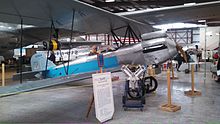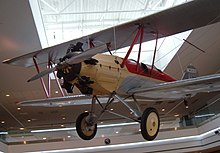| Industry | Aerospace |
|---|---|
| Predecessor | Alexander Film Company |
| Founded | 1925 (1925) |
| Defunct | August 1932 (1932-08) |
| Successor | Aircraft Mechanics, Inc |
| Headquarters | Englewood, Colorado, United States |
| Key people |
|
| Parent | Alexander Industries |

The Alexander Aircraft Company was an aircraft manufacturer founded in Colorado in 1925. It was briefly the world's largest aircraft manufacturer but fell victim to the Great Depression and became bankrupt in 1932.
History
Founding
The company began life as an offshoot of the Alexander Film Company that specialized in film advertising, and the younger J. Don Alexander decided that they could sell more advertising if they had airplanes. He wrote to aircraft manufacturers asking for a quote on 50 airplanes, but the builders ignored his letter as the work of a crackpot. Alexander decided to build his own. He moved his operation to Englewood, Colorado and set up the aircraft company. He sent Justin McInaney to Marshall, Missouri to buy an airplane and learn to fly. Justin's instructor was the great Ben O. Howard, who later became famous as a racer and test pilot. Justin bought a Swallow airplane for $2,300 and flew it back to Denver, a trip with many forced landings. Justin then taught others to fly, including Jack Frye (later president of TWA) and airplane designer Al Mooney. Sales of the aircraft reached eight aircraft a day, just before the depression hit.
Disaster
By 1928, the company was having trouble meeting demand from its jury-rigged factory in Englewood. Operating from a small town enabled the company to evade fire and building codes, but there were rumours that Englewood would be annexed by nearby Denver and regulations would be enforced. The company directors began to prepare for a move to other cities while using the threat of leaving to extort concessions out of the town.
Just before noon on 20 April 1928, a fire started in the shed where aircraft wings were coated with highly flammable cellulose nitrate 'dope.' A back room was crowded with seamstresses sewing fabric. All of the windows were high and barred, the walls and floors were soaked in the flammable chemical, as were the uniforms of the workers. The only exits from the building were in the doping room and opened inwards. The doping shed was engulfed in fire and explosions, the exits became crowded with fleeing workers, and eleven workers were burned alive. Many others were horribly burned.
Both Alexander brothers and three other company officials were charged with voluntary manslaughter. They pleaded guilty to failure to provide sufficient means of escape, failure to have doors opening outward, failure to provide proper ventilation, and failure to provide proper sanitation in exchange for the manslaughter charge being dropped. They were fined a total of $1,000 and given suspended 90-day jail sentences.
Expansion
See also: Alexander Airport (Colorado Springs)With its Englewood factory closed by the Arapahoe County Sheriff, the company moved overnight to new facilities they were building in Colorado Springs.
By 1931 the company had an established manufacturing plant between Pikeview and Roswell in El Paso County, west of the Atchison, Topeka and Santa Fe Railway and U.S. Route 85. The company went bankrupt in August 1932 and was acquired by Aircraft Mechanics Inc., founded by W. F. Theis and Proctor W. Nichols, in April 1937. It produced components for the Douglas Aircraft Company during World War II, US Air Force ejection seats, and Space Shuttle crew seats.
Legacy
For a brief period from 1928 to 1929, Alexander was the largest aircraft manufacturer in the world, and more aircraft were built in Colorado than anywhere else in the world. In the early 1930s, the firm built a revolutionary new plane—the forerunner of modern aircraft, with a low wing and retractable gear—called the "Bullet". Several of them crashed in the testing process because the government insisted that the unspinnable plane be tail-spun. The plane later was certificated, though, and became famous in racing and civil aviation. The depression and losses suffered in the Bullet program forced the aircraft firm to fold in the mid-1930s. Alexander would also be known for starting the career of Al Mooney, the founder of Mooney Aircraft, a general aircraft manufacturer that continues in operation in Kerrville, Texas.
Aircraft


| Model name | First flight | Number built | Type |
|---|---|---|---|
| Alexander Eaglerock | 1925 | 893 | Two seat biplane |
| Alexander Bullet | 1929 | 12 | Four seat low-wing monoplane |
| Alexander Flyabout D-1 | 1931 | 3 | Two seat monoplane |
| Alexander Flyabout D-2 | 1931 | 15 | Two seat monoplane |
Notes
- The Alexander Film Company was once the world's largest producer of theater film advertising, which was shown before trailers and ahead of the film. At its peak in the early 1950s, Alexander Film Company was producing 2000 to 3000 advertisement films annually and had an annual payroll over $2.5 million. Clients included a "who's who" of the nation's leading manufacturers including Ford, GM, U.S. Rubber, Philco, and Seven-Up. In the late 1950s it was "blacklisted" by industry professionals for opposing unionization, making it impossible for national advertisers to use their commercials, resulting in its collapse.
References
- Pattillo, Donald M. (1998). A History in the Making: 80 Turbulent Years in the American General Aviation Industry. McGraw-Hill. p. 8. ISBN 0070494487.
- ^ Gilbert, David; Underwood, Reed (2017-03-13). "The Alexander Blast: Englewood's Deadliest Disaster". www.davidgilbertwrites.com. Archived from the original on 2022-12-09. Retrieved 2023-02-13.
- Newberg, Ronald E. (April–May 2000). "Alexander Eaglerock Biplane". Southwest Aviator. Albuquerque: Southwest Regional Publishing, Inc. Retrieved 2023-02-13.
- United States Geological Survey (1949). Colorado Springs (Map). 1:25,000. Paul Freeman. Retrieved 2023-02-14.
- Alexander factory Colorado Springs (photograph) (black & white print). Denver Public Library. 1931. X-14276. Retrieved 2023-02-14.
- "Alexander, Aircraft Mechanics". www.aerofiles.com. Aerofiles. 2006-07-11. Retrieved 2023-02-14.
Aircraft operations into bankruptcy. 1934: Reorganized as Aircraft Mechanics Inc (fdr: Proctor W Nichols, W F Theis), 3200 N Nevada St, Colorado Springs.
- Sturdevant, Rick W. (2011). "Aeronautics and Astronautics: Civil Aviation: Pioneering Air & Space Business in the Pikes Peak Region". In Blevins, Tim; Daily, Dennis; Dean, Synde; Nicholl, Chris; Olsen, Michael L. (eds.). Enterprise & Innovation in the Pikes Peak Region. Pikes Peak Library District & Dream City Vision 2000. p. 183. ISBN 978-1-56735-302-0.
- Baxter, Gordon (2010-10-28). "The Al Mooney Story: They All Fly Through the Same Air". www.mooneyevents.com. Mooney Aircraft Owners' Events. Retrieved 2023-02-14.
External links
- Sketch of Alexander Aircraft Company manufacturing plant buildings
- Colorado Aviation Historical Society. Archived 2020-06-05 at the Wayback Machine
- Alexander Eaglerock in the collection of the Seattle Museum of Flight
- Listing of Alexander model types
- Biography of J. Don Alexander
- The Bullet Project. Archived 2016-03-03 at the Wayback Machine
- Al Mooney designs for Alexander Aircraft
- Alexander Industries Collection – History Colorado
- Alexander Industries Records – Pikes Peak Library District
| Alexander aircraft | |
|---|---|